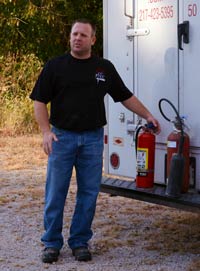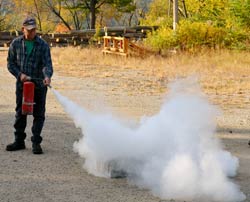
Is Your Safety Committee Effective?PDRMA introduced its How to Establish and Lead an Effective Safety Committee course in 2015, and Decatur Park District was an early registrant. Why was the agency so eager to attend? Because Decatur knew its Safety Committee could play a larger role in improving the safety culture by more effectively getting the word about safety out to all employees. PDRMA members are discovering they can use the class resources and discussions to revitalize and redirect their safety committees.
“Early this year we decided the committee needed to grow and include more than just our maintenance supervisors if we wanted to spread the safety message to all employees, especially our seasonal staff,” explains Kristi Orrick, Human Resources and Risk Manager, Decatur Park District.
The re-energized Safety Committee grew to include several recreation and facility supervisors. The executive director also spoke at the kick-off meeting, strongly voicing his support and encouraging the committee members to partner with PDRMA to bring the safety message to all agency staff.
“We shared our loss report with attendees — and later with all full-time employees — to help everyone understand our metrics, identify our benchmarks for improvement, and drive home the point that safety is everyone’s responsibility,” recalls Orrick. “We also held a training session on accountability to impress upon all staff our renewed focus on safety and our commitment to make everyone responsible for promoting our safety culture.”
 The agency packs a lot into each monthly committee meeting, and attendance is mandatory; if a member can’t attend, he must send an alternate. In addition to reviewing the loss trends provided by PDRMA, each meeting includes a training session, sometimes with a guest speaker. “The monthly training topics allow us to prepare activities ahead of time to make each meeting informative and interactive,” Orrick says, adding that guest speakers energize meetings with hands-on training. For example, in October — fire safety month — Decatur had a local company present fire extinguisher training. The agency packs a lot into each monthly committee meeting, and attendance is mandatory; if a member can’t attend, he must send an alternate. In addition to reviewing the loss trends provided by PDRMA, each meeting includes a training session, sometimes with a guest speaker. “The monthly training topics allow us to prepare activities ahead of time to make each meeting informative and interactive,” Orrick says, adding that guest speakers energize meetings with hands-on training. For example, in October — fire safety month — Decatur had a local company present fire extinguisher training.
Orrick found the information from PDRMA’s to be a huge advantage. “The Safety Committee Quiz that was part of the How to Lead an Effective Safety Committee training was very helpful. We’ve been using the loss trends report to share our agency’s progress with the committee, and we’ve seen improvements since the beginning of the year. We also use several of PDRMA’s LRN resources, posters, training videos and photo observations to guide our meeting discussions.
 “We shared PDRMA’s feedback form at a meeting about safety observations and were surprised about how some members felt when it came to monitoring staff safety practices,” Orrick adds. “We now require all safety committee members to complete at least four safety observations each month. It helps them recognize when employees are doing things well but also allows them to provide recommendations when they see employees not following CORE 6. Plus, it encourages them to think about safety when planning events or daily projects and to share safety tips each morning when they assign tasks to staff for the day.” “We shared PDRMA’s feedback form at a meeting about safety observations and were surprised about how some members felt when it came to monitoring staff safety practices,” Orrick adds. “We now require all safety committee members to complete at least four safety observations each month. It helps them recognize when employees are doing things well but also allows them to provide recommendations when they see employees not following CORE 6. Plus, it encourages them to think about safety when planning events or daily projects and to share safety tips each morning when they assign tasks to staff for the day.”
Fox Valley Park District is another veteran of the How to Lead an Effective Safety Committee training. Its Safety Committee includes a representative from each facility — mostly managers and supervisors from the administration, recreation, parks, maintenance and police departments. The committee meets once a month for an hour with the agenda divided into specific sections: Safety Training, Safety Incentive, Safety Stats, Incidents, and New Business. The meetings are the same day and time each month, and attendance is mandatory.
 “Managers review events in their departments and develop action plans and training to mitigate future events,” explains Diane Erickson, Director of Finance, Fox Valley Park District. “Committee members see and hear firsthand the benefits of the meeting and how safety training has reduced our liability and costs. They take the information back to share with supervisors and employees. “Managers review events in their departments and develop action plans and training to mitigate future events,” explains Diane Erickson, Director of Finance, Fox Valley Park District. “Committee members see and hear firsthand the benefits of the meeting and how safety training has reduced our liability and costs. They take the information back to share with supervisors and employees.
“The Safety Committee meetings encourage everyone — for at least one hour each month — to focus on safety and only safety,” points out Erickson, “and that leads to good risk management.” One example involves the agency’s zip line at the Blackberry Farm museum. It had extensive damage from wear and tear, upkeep costs were rapidly increasing and so was the risk of patron injury if the line broke.
“Through our Safety Committee meetings, we were able to identify another vendor with lower maintenance costs and better system functionality,” she explains. “Each concern presented by a committee member immediately becomes a problem to solve. The members suggest solutions that, in most cases, are made quickly and effectively, eliminating the need to wait to find an appropriate answer.”
Erickson urges other agencies to consider carefully who should be a Safety Committee member. “To be effective, the committee needs the support of upper management so ideas and recommendations can be funded and implemented,” she adds. “Selecting individuals who truly want to make a difference and understand their roles and responsibilities creates the most effective Safety Committee.”
PDRMA Resources:
|

